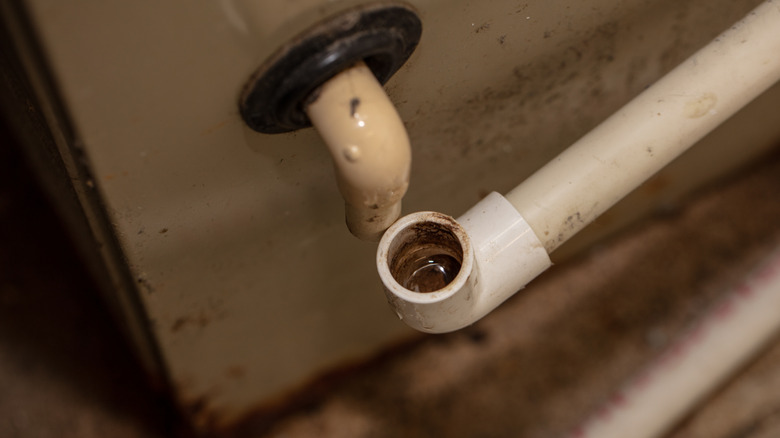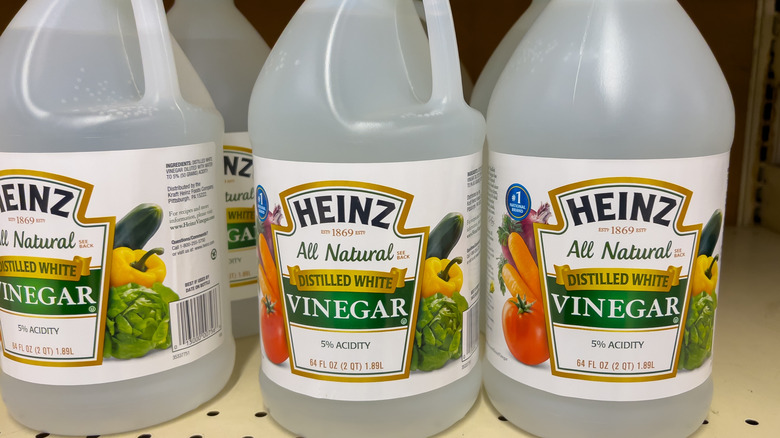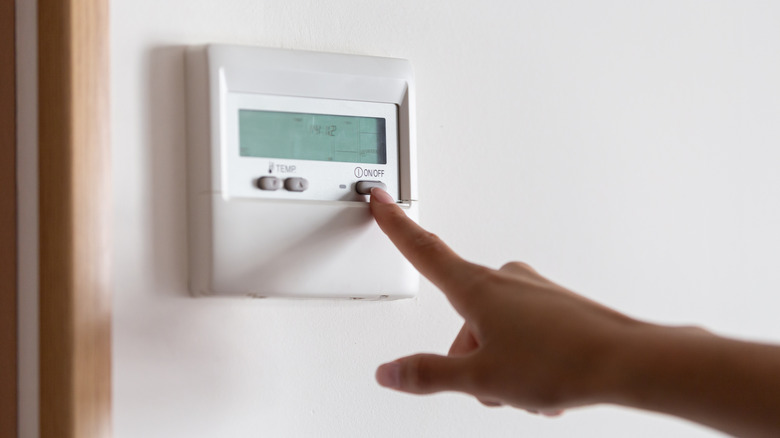Avoid Your AC Unit From Getting Clogged With A Simple Step Using A Kitchen Essential
If you are wondering why your air conditioner is making noise and how to fix it, there are quite a few potential issues. Some air conditioner problems are complex and will require an HVAC technician's work, but others can be prevented or improved with some DIY maintenance. One example of this is a clog in your air conditioner's condensate drain line. If you notice a musty or moldy smell, standing water or water damage indoors near your air conditioning unit, ineffective cooling, or issues with your unit turning off and not turning back on, you may be dealing with a clogged condensate drain line. Clogs here occur when dirt, dust, and other debris get caught in the moisture inside the drain line pipe, so it is important to clear it out. While you may want to hire a professional, another potential solution is to clean the drain line out using vinegar.
This DIY solution involves pouring distilled white vinegar down the condensate drain line in your home's central air conditioning unit to gently clean the pipe, dislodge minor clogs, and prevent it from shutting down. While it sounds easy enough, there are some important safety precautions to take, and the process might be more involved than you initially anticipate if the clog is severe. Improper care for clogs can lead to moisture issues, rust, and a shorter lifespan for your air conditioner, so it is important to understand if vinegar is a good solution for you, how to use it, and what to do if vinegar is ineffective for your unit.
Does vinegar actually help prevent your AC unit from clogging?
If you search how to clean a clogged condensate drain line, many air conditioner information websites will recommend using vinegar, especially distilled white vinegar. Vinegar is a common household cleaning ingredient because it is non-toxic, environmentally friendly, and found in most homes. Before you start dumping it into your air conditioner, you should know more about how vinegar can be a versatile cleaning tool. Vinegar is made of acetic acid, which allows it to dissolve dirt, mineral deposits, and more when the concentration of acetic acid is high enough. Most HVAC websites recommend white vinegar or distilled white vinegar, both of which have a concentration of 5%.
Additionally, vinegar can help remove mildew smells, which is especially helpful if a mold or mildew smell is one of the signs that alerted you to your clogged drain line. Overall, if you use a high enough concentration, vinegar should be effective for minor clogs, but you may also need to use a wet/dry vacuum, a plumber's snake, or even a garden hose to remove the clog.
While the vinegar solution sounds simple enough, it is also important to note that vinegar is corrosive to metals and can damage nearby components during the process if you are not careful enough. If you are willing to give the process a try, despite the potential damage to nearby metal, it is important to take proper safety and preparation steps and work attentively throughout the process.
How to use vinegar to clean your AC condensate drain line
To give this vinegar solution a try, start by turning off your thermostat and the breaker to ensure that the air conditioner is completely off. Next, find your condensate drain line. These drain lines are typically white PVC pipes found indoors. They often have a vent in a T shape with a removable cap. Remove this cap to access the location where you will pour in the vinegar. If you check inside this pipe, you may be able to see your clog. Pour in about one-fourth of a cup of distilled white vinegar, and let it sit inside the pipe for 30 minutes. Use a funnel to help you pour if necessary.
Then, rinse the drain with clean water. If the drain remains clogged, you may need to use your vacuum or hose at this point to remove debris that was not dissolved by the vinegar's acid. You might also consider using a vinegar with a higher acid concentration, but again, you need to be careful with this method. Continue to rinse until the drain line runs clean. Finally, replace the cap and turn your unit back on. It is recommended that this process is repeated monthly to prevent large clogs from building up.
If you are still experiencing issues, you may need to call an HVAC professional to assess the issue. They can more thoroughly clean the drain line or diagnose other issues that may be causing your unit's problems. Even if you know how to clean your drain line, there are other reasons you should have your HVAC system checked annually, so it may be worth a call.


